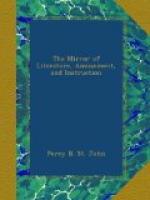ROSAMOND’S WELL AND LABYRINTH.
[Illustration: Rosamond’s Well and Labyrinth at Woodstock.]
For the originals of the annexed engravings we are indebted to the sketchbooks of two esteemed correspondents.[1] The sites are so consecrated, or we should rather say perpetuated, in history, and the fates and fortunes of Rosamond Clifford are so familiar to our readers, that we shall add but few words on the locality of the Well and Bower. Their existence is thus attested by Drayton, the poet, in the reign of Queen Elizabeth:—“Rosamond’s Labyrinth, whose ruins, together with her Well, being paved with square stones in the bottom, and also her Tower, from which the Labyrinth did run, are yet remaining, being vaults arched and walled with stone and brick, almost inextricably wound within one another, by which, if at any time her lodging were laid about by the queen, she might easily avoid peril imminent, and, if need be, by secret issues, take the air abroad, many furlongs about Woodstock, in Oxfordfordshire.”
Sir Walter Scott (of whom, as of Goldsmith, it may hereafter be said, he “left no species of writing untouched or unadorned by his pen”) has resuscitated the interest attached to this spot, in his masterly novel of Woodstock.[2] It is here that the beautiful Alice meets the facetious Charles in his disguise of an old woman; and on the bank over the Well is the spot where tradition relates fair Rosamond yielded to the menaces of Eleanor. Our correspondent, T.W., jocosely observes, that he sends us the Labyrinth “without the silken cord which guided the cruel Eleanor to her rival, in the hope that the ingenuity of the reader will be sufficient to serve him in its stead. Observe,” continues he, “the maze is entered at one of the side gates, and the bower must be reached without any of the barriers (—) being passed over—that is, by an uninterrupted pathway."[3]
The bower consists of fine tall trees, whose branches hang entwined over the front of the well. The spring is contained in a large basin, formed by a plain stone wall, which serves as a facing and support to the bank; the water flows from hence through a hole of about five inches in diameter, and is conveyed by a channel under the pavement into another basin of considerable dimensions, fenced with an iron railing. Hence it again escapes by means of a grating into the beautiful lake of Woodstock Park, or, as it is more modernly termed, Blenheim.
In these days of “hobgoblin lore,” it may not be incurious to add, that Woodstock is distinguished in Dr. Plot’s History of Oxfordshire (the title of which is well known to all readers of the marvellous) as the scene of a series of hoax and disturbance played off upon the commissioners of the Long Parliament, who were sent down to dispark and destroy Woodstock, after the death of Charles I.; and Sir Walter Scott thinks it “highly probable”




